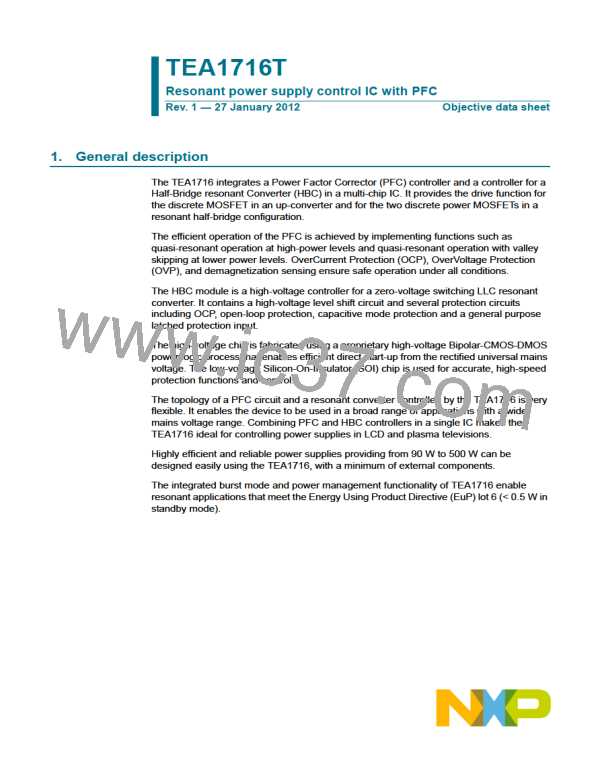TEA1716T
NXP Semiconductors
Resonant power supply control IC with PFC
on
GATEPFC
V
off
Boost
V
Rect
Dr(PFC)
0
V
/N
0
Rect
Aux(PFC)
V
demag(SNSAUXPFC)
(V
− V
)/N
Boost
Rect
l
Tr(PFC)
0
demagnetized
Demagnetization
magnetized
Valley
(= top for detection)
t
014aaa856
Fig 8. Demagnetization and valley detection
The valley sensing block connected to the SNSAUXPFC pin detects valleys. This block
measures the voltage at the auxiliary winding of the PFC transformer, which is a reduced
and inverted copy of the MOSFET drain voltage. When a valley of the drain voltage (= top
at SNSAUXPFC voltage) is detected, the MOSFET is switched on.
If no top is detected on the SNSAUXPFC pin (= valley at the drain) within tto(vrec)
(4 s typical) after demagnetization was detected, the MOSFET is forced to switch on.
7.7.5 PFC frequency and off-time limiting
For transformer optimization and to minimize switching losses, the switching frequency is
limited to fmax(PFC). If the frequency for quasi-resonant operation is above fmax(PFC), the
system switches to Discontinuous conduction mode. The PFC MOSFET is switched on
when the drain-source voltage is at a minimum (valley switching).
The minimum off-time is limited to toff(PFC)min to ensure proper control of the PFC MOSFET
under all circumstances.
7.7.6 PFC soft start and soft stop (pin SNSCURPFC)
The PFC controller features a soft start function, which slowly increases the primary peak
current at start-up. It also features a soft stop function which slowly decreases the
transformer peak current, before operations are halted. This is to prevent transformer
rattle at start-up or during Burst mode operation.
TEA1716T
All information provided in this document is subject to legal disclaimers.
© NXP B.V. 2012. All rights reserved.
Objective data sheet
Rev. 1 — 27 January 2012
18 of 46

 ETC [ ETC ]
ETC [ ETC ]